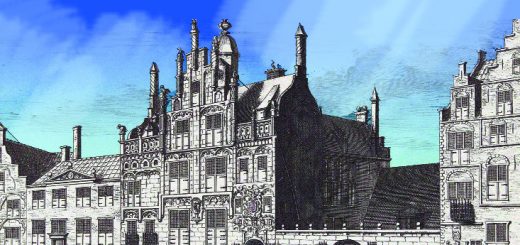The Oldest University in the World and the Muslim Woman who Found it -Ahmad Ullah
Two most famous universities of the modern world, Cambridge and Oxford, were founded in 1209 and 1096, respectively. However, none of these are the first universities in the world, not even in Europe. The oldest university in the world is Morocco’s Al-Qaraween University, which was founded in 859 A.D.
According to UNESCO and Guinness Book of World Records, it is the oldest university and degree-granting institution in the world, which is still in operation. And this historic university was founded by a Muslim woman, Fatima Al-Fihri!
Fatima al-Fihri was born around 600 AD, in the city of Kairawan in present-day Tunisia. Her full name is Fatima bint Muhammad al-Fihriya al-Quraishi. Their family name suggests from the Quraish part that they were the heirs of the Quraish dynasty.
The city of Kairawan in Tunisia was founded by the Umayyad rulers in 60 AD. In the early ninth century, the city became one of the most important centers of Islamic learning, culture and civilization. Many family living in the city, were financially indigent. As a result, a few years after Fatima’s birth, at the beginning of the ninth century, several families from the city of Kairawan left the city together in search of fortune, heading for Fez, the famous city of the Islamic Maghreb.
Fez was then a growing cosmopolitan city. People of different religions, castes and professions from different countries were coming and settling there. At that time the ruler of Fez was Sultan Idris II. He was a very devout Muslim and a just ruler. He arranged for the immigrants to live on the slopes of the Fez River. Coming from Kairawan, these immigrants who settled in Fez are known as Karawin, or residents of Kairawan.
Mohammad Al-Fihri’s fate was decided when he came to Fez. Through hard work, She established himself as a successful businessman. He provided good education for her children. Fatima al-Fihri and her sister Maryam al-Fihri studied classical Arabic, Islamic jurisprudence, and hadith.
After growing up, Fatima’s father married her in this Fez. But after a few years of marriage, disaster struck Fatima’s family. Shortly after, her father, brother and husband died. Only orphaned sisters Fatima and Maryam remained. They inherited a large amount of property left by their father.
Under Muslim inheritance law, daughters are not held accountable for spending property inherited from their fathers. Fatima and Mariam could have spent the property anyway if they wanted. But instead of spending on luxuries, they decided to spend the money for the welfare of humanity.
Fez’s fame was growing day by day. Devotees from home and abroad were coming and living in the city. Fatima and Maryam noticed that the central mosque in Fez was no longer able to accommodate the city’s growing worshipers. As a result, they decided to build two separate mosques with the property left by their father. At about the same time, the two sisters built two separate mosques in the nearby area. Mariam built the Andalusian Mosque and Fatima built the Carawin Mosque.
Not much is known about Fatima, not even in her established caraween library. The oldest source to describe Fatima is The Garden of Pages, written by the fourteenth-century historian Ibn Abi-Zara. According to him, Fatima first began purchasing land to build her mosque, and then on December 3, 659, she began work on the mosque. It was a Saturday in the holy month of Ramadan. Fatima did not end her duty just by donating money to build a mosque. He himself supervised its construction from the present all the time. And he fasted every day from the beginning to the end of the construction.
According to some accounts, it took 18 years to complete the construction of the mosque, although other accounts give 11 years and 2 years. On the day the construction is completed, he enters the mosque he has built and prays and expresses his gratitude to Allah. He named the mosque after his hometown Kairawan.
After the construction of the mosque was completed, Fatima built a madrasa in the extension of the mosque. In a short time, besides Islamic education, lessons on grammar, mathematics, medicine, astronomy, history, chemistry, geography and other subjects were started there. It is the oldest of the educational institutions offering degrees for formal education on a variety of subjects, which still survives and has enlightened people by providing continuous education for the last eleven and a half years.
Fatima’s Caraween Mosque and Caraween University continue to be the main centers of Islamic education in Africa. Not only Muslims, but also many famous Jewish and Christian scholars of the Middle Ages have graduated from this university. One of its students was Pope Sylvester II, who learned the concept of Arabic numerals from here and spread the knowledge in Europe and introduced Europeans to the concept of the first zero (0). The famous Maliki judge Ibn al-Arabi, the historian Ibn Khaldun and the astronomer Nuruddin al-Bitruji were involved in teaching at this university at different times. After the establishment, Fatima herself studied here for some time.
Caraween University Library is also considered to be the oldest library in the world. Even though a large number of manuscripts were destroyed by fire, it still contains some 4,000 ancient and rare manuscripts. These include a ninth-century Qur’an, a collection of hadiths, Imam Malik’s book Muwatta, a biography of the Prophet (peace be upon him) written by Ibn Ishaq, Kitab al-Ibar by Ibn Khaldun, and various rare books, including the original manuscript of al-Muqaddima.
Fatima al-Fihri died in 880 AD. But the caraween mosque, university and library she founded still stand proudly today. Millions of students have graduated from her established university in the last millennium. Fatima’s contribution to enlightening her fellow Arabs, the Muslim world and, above all, to the human community in the light of knowledge and enriching the world’s knowledge is immense. n
















Recent Comments